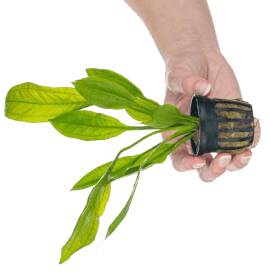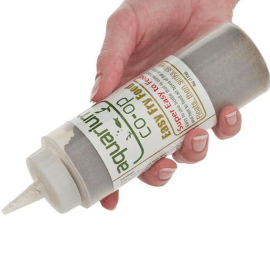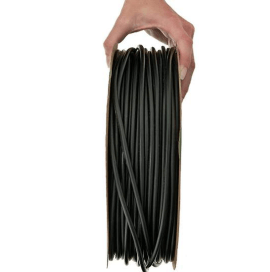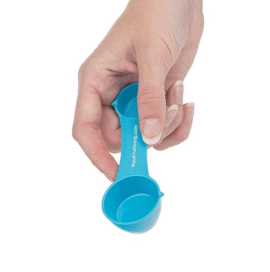Top 10 Pufferfish You Can Keep in Freshwater and Brackish Aquariums
Out of all the oddball fish, we’ve always had a fascination with puffer fish because of their highly intelligent nature, helicopter-like maneuverability, and large, inquisitive eyes. Plus, they have unique defense mechanisms, such as inflating like a living water balloon and carrying the tetrodotoxin poison that discourages would-be predators. (Note to self: do not try to eat a pet puffer.) Most pufferfish are semi-aggressive to aggressive carnivores with ever-growing teeth like a beaver, so you mainly feed them crunchy foods to wear down their incisors. Also, expect to clean the tank regularly since they are messy eaters that may not necessarily tolerate other cleaner fish or algae eaters.
When choosing a puffer fish, focus on finding a healthy specimen with a nicely rounded abdomen. Since they can be picky eaters, find out from a store employee what the puffer has been consuming and consider asking for a demonstration to make sure it’s eating well. Many species of pufferfish are wild-caught and come with various pathogens, so we like to preventatively treat them with the quarantine medication trio to clear out their systems of existing infections. Even though they are considered to be “scaleless” fish, we have treated thousands of puffers using these medicines with great success. Also, puffer fish seem especially prone to internal parasites like tapeworms, so we like to apply additional treatments of dewormer with these instructions.
Do pufferfish puff up? Yes, they can suck in water or air to increase their size and make it more difficult for predators to consume them. However, they usually only do this in times of great stress, so do not try to scare your puffer to induce this behavior. Instead, you can view pictures and videos online to see them in action. To limit their anxiety during transport, scoop them up with a plastic tub or container instead of a fish net to prevent them from sucking in air. In rare instances, you may be able to catch your puffer inflating a little just for practice.
I. Nano Puffer
Dwarf or Pea Puffer

Dichotomyctere ocellatus or Tetraodon biocellatus
The smallest pufferfish in the world is called by many names like pea puffer, Indian dwarf puffer, and pygmy puffer. This freshwater fish comes from the southwestern tip of India and enjoys waters with 74–82°F (23–28°C), pH from 6.5–8.4, and moderate hardness. Even at this tiny size, they can be territorial, so some hobbyists like to keep just one dwarf puffer in a 5-gallon fish tank by itself or in a group of one male for every two to three females. To make sure they have enough space to escape the male’s attention, you can try three puffers in a 10-gallon aquarium or six to seven in a 20-gallon tank. Unlike most of the puffers in this list, there is no need to provide crunchy foods or trim their teeth. We like to feed ours a mix of live and frozen foods — including bloodworms, brine shrimp, small pest snails, and white worms — and they can be taught to eat Hikari Vibra Bites, which looks like bloodworms. For more details, read their full care guide.
II. Community Puffers
Amazon or South American Puffer (SAP)
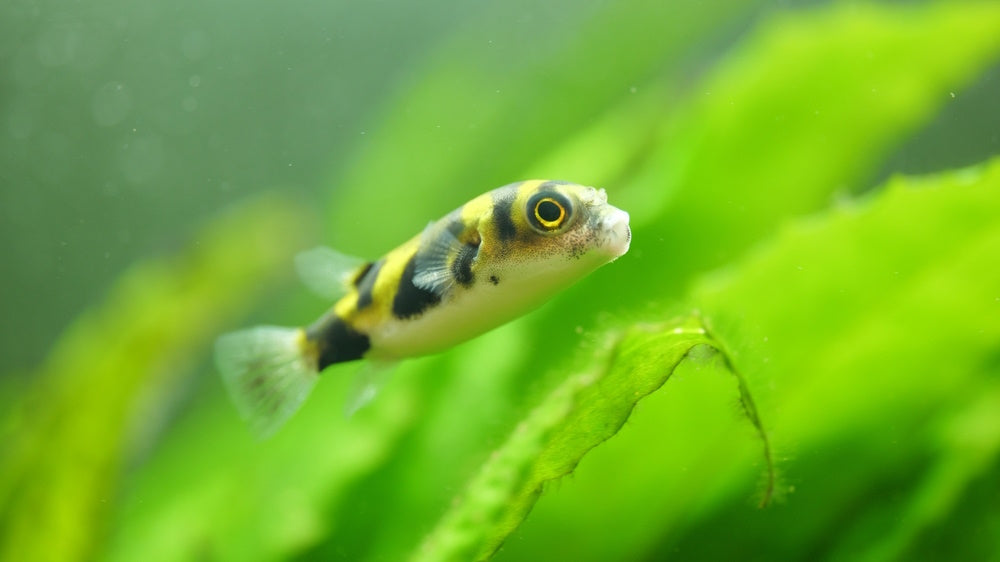
Colomesus asellus
As per their common name, this gorgeous, 4-inch (10 cm) puffer comes from the Amazon basin and is hardy enough to live in 72–82°F (22–28°C), pH levels of 6.0–8.0, and soft to hard water. It has a golden yellow body with black, irregular splotches on the back that almost look like a bumblebee pattern. The SAP is relatively calm compared to other puffers, but it still has a feisty temperament and may fin nip slower fish. You can keep one by itself or get a group of six or more in a 40- to 55-gallon planted tank or larger. As for tank mates, we recommend keeping them with other similar-sized, active fish — like mollies, swordtails, larger tetras, and dwarf cichlids.
This particular species is notorious for getting overgrown teeth, even if their diet only consists of hard foods like pest snails and freeze-dried krill, so some hobbyists have trained them to eat Repashy gel food. This versatile staple can be mixed with crushed oyster shells (sold as chicken feed) for added toughness or dipped on rocks so that the puffers have to scrape their teeth against a hard surface to eat it. If their teeth get too long, they won’t be able to eat properly and may starve to death, so read the full article to learn how to trim their teeth.
Spotted Congo Puffer
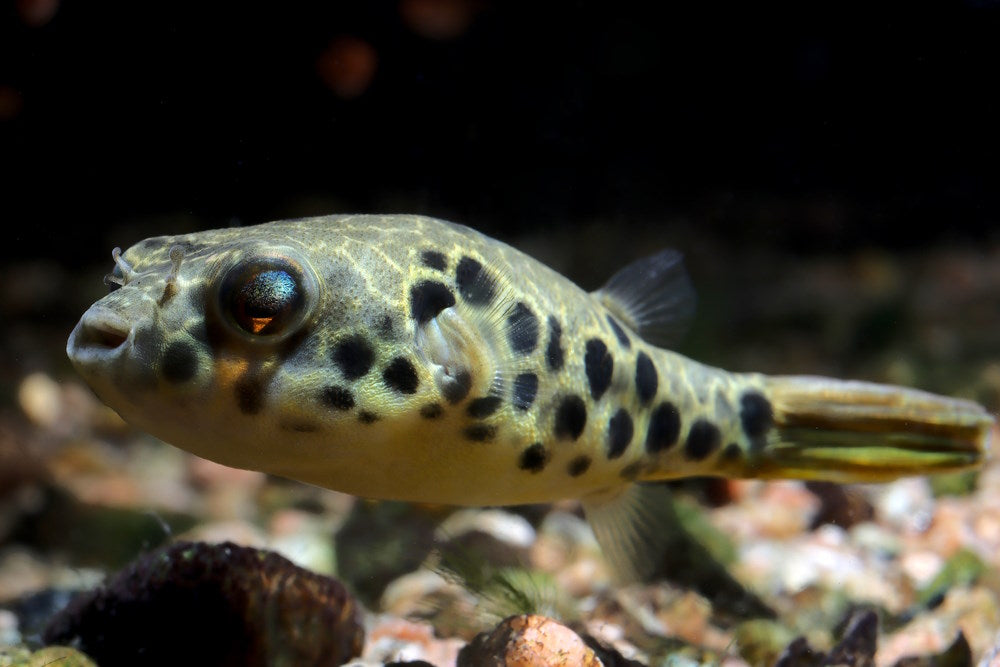
Tetraodon schoutedeni
Another puffer that can be potentially kept in a community setting is the Schoutedeni puffer fish. As one of the smallest African puffers, this 3- to 4-inch (8–10 cm) fish comes from the freshwater Congo basin and prefers 74–80°F (23–27°C), neutral pH levels, and moderate to hard water. Its appearance includes a tan-colored back, yellowish belly, and black spotting. A single puffer can live in a 30-gallon tank, while a group (with more females than males) would need a larger setup. To minimize aggression, use live aquarium plants or other decorations to break line of sight and create lots of hiding spots. Potential tank mates include faster fish that won’t outcompete them for food, such as Congo tetras, peaceful plecos, corydoras, and rainbowfish. Feed them plenty of snails, worms, insects, and frozen foods, and soon you may see some breeding behavior occur.
III. Ambush Puffers
Arrowhead or Pig-Face Puffer

Pao suvattii or Tetraodon suvattii
In this category of freshwater puffers, we are looking at true ambush predators that spend most of their time keeping very still, waiting for prey to swim by. They are most active during mealtimes, and because of their sedentary nature, many hobbyists don’t feed them every day, especially in adulthood. The arrowhead pufferfish grows to 4.5–6 inches and only needs a 30- to 40-gallon aquarium to call home. It has a brown, patterned back with some spotting and a light-colored belly. Give it lots of cover with plants and hardscape, and then set up a deeper sand bed so it can “wallow” or bury itself in the ground. Temperatures can range from 72-79°F (22-26°C) with neutral pH levels and moderate hardness.
As an aggressive carnivore, the pig-faced puffer will eat other fish and fight with its own species, so the best thing to do is to give it a bachelor or bachelorette pad for itself. Because you’re dedicating an entire aquarium to only one fish, these ambush predators tend to attract only the most dedicated puffer enthusiasts or seasoned veterans who own lots of other tanks. Feed them all kinds of live or frozen worms, diced fish filets, snails, clams on the half shell, and shrimp.
Hairy Puffer

Pao baileyi or Tetraodon baileyi
The hairy puffer is similar to the arrowhead puffer with its mottled brown color, but it looks like it has a beard around the lower jawline and on its body. These little skin tabs help camouflage the ambush predator so it looks like a round rock with algae tufts growing on it. Both the hairy and arrowhead puffer fish come from Southeast Asia from waterways that have medium to strong current, so don’t be afraid to install a powerhead to imitate its natural habitat. At 5 inches (13 cm) long, they do best in solitary confinement in a 30-gallon aquarium with 75-80°F (24–27°C) and neutral to alkaline pH. A deep sand bed is a must so it can cover itself in fine substrate, but because it might dig up your plants, go for aquarium plants that don’t require substrate (e.g., anubias, java ferns, and floating plants). They like eating worms, snails, crustaceans, insects from the reptile store, and diced fish filets. If you don’t prefer to feed live foods, many hobbyists have trained their hairy puffer to eat mostly frozen foods and even Repashy gel food.
Dragon or Humpback Puffer

Pao palembangensis or Tetraodon palembangensis
The dragon pufferfish is a larger, 8-inch (20 cm) ambush predator that has a brown back with mottled patterns and round spots to help blend in with the substrate. It comes from slow-moving waterways in Southeast Asia with temperatures around 75–82°F (24–28°C), 6.8–7.6 pH, and moderate GH. Most humpback puffer fish are wild-caught, so to help your new wet pet acclimate to its new environment, your main goals are to deworm it, feed it well, and provide plenty of cover.
This solo fish will not tolerate tank mates and thus would be fine in a 40-gallon tank. While it doesn’t burrow in the substrate, it would appreciate hiding amongst some hardscape, plants, and leaf litter with brown tannins. As a carnivore with a strong beak or teeth, feed it crunchy foods like freeze-dried krill, bloodworms, and clams on the half shell. If you have a hard time getting it to eat, you may need to try live foods like snails and small fish that have been through quarantine. (Remember not to feed too many feeder goldfish or minnows because they contain high amounts of thiaminase, which prevents your predator fish from absorbing vitamin B1 and can cause health issues.)
IV. Brackish Puffers
Figure Eight or Eyespot Puffer

Dichotomyctere ocellatus or Tetraodon biocellatus
Don’t be intimidated by these brackish pufferfish that live in a mix of salt and fresh water! Unlike the corals in marine reef tanks, brackish water species do not require a precise amount of salt, which you can read more about in our tutorial on how to easily set up a brackish tank. At 2–3 inches (5–8 cm) long, the figure 8 puffer is one of the smaller puffers on this list and gets its common names from the yellow-green squiggles on its back that look the number 8 and black dots that look like eye spots.
They tend to enjoy low end brackish water with a specific gravity (SG) of 1.005—1.008, alkaline pH, moderate to hard GH, and 72–79°F (22–26°C). Figure eight puffers are very active and therefore do well in a 20-gallon long tank or longer that has both open spaces for swimming and decorations to help break line of sight. While they are relatively chill for a puffer, they can fin nip, so avoid tank mates that are slow-moving or have flowy finnage. We’ve successfully paired them with bumblebee gobies and mollies in the past. As with most puffers, they like to eat pest snails, ghost shrimp, frozen foods, and freeze-dried krill.
Green Spotted Puffer (GSP)

Dichotomyctere nigroviridis or Tetraodon nigroviridis
The green spotted puffer is another striking, brackish water species that has a bright yellow-green back covered in black spots and a light-colored belly. Growing up to 4–6 inches (10–15 cm), it too is fairly active and always hunting food, so we like to put them in a 30- or 40-gallon aquarium with 76–82°F (24–28°C) and pH of 7.5–8.5. Using crushed coral or aragonite sand as the substrate can help buffer the pH and keep it in the alkaline range. Most stores keep them in fresh water, which is not good for their long-term health, so you may need to slowly acclimate to them to an SG between 1.004–1.020. There aren’t a lot of plants that do well in brackish water, but we have had good luck with java fern and mangroves.
Tank mates can be a little tricky because these pufferfish are an aggressive species, but if you include plenty of line-of-sight breaks and increase the tank size, you can keep them with larger mollies, knight gobies, and scats. They will eagerly consume all kinds of live, frozen, and freeze-dried foods — such as bloodworms, snails, mealworms, and small crabs. In our experience, GSPs can take down almost anything with a shell that is up to half their size.
V. Giant Puffers
Fahaka or Lined Puffer

Tetraodon lineatus
The first of our monster puffers has beautiful yellow striping against a darker, mottled back and can grow up to 12–17 inches (30–43 cm). Because of their size, it will need at least 120–180 gallons of water at 75–80°F (24–26°C), alkaline pH, and moderate to hard GH. The layout should include open areas to explore, live aquarium plants to rest in, and finer substrate if you have a juvenile that likes to bury itself. Fahaka puffers tend to be aggressive towards other puffers and tank mates, but it totally depends on the individual’s personality. Some hobbyists have kept them with peaceful plecos, rainbowfish, and roseline sharks, while others recommend much smaller fish that are too little to be noticed or too fast to be easily caught — like zebra danios, peaceful barbs, and tetras.
Tank mates can be useful as clean-up crew members because puffers are usually messy eaters and require more tank maintenance. As a larger fish, offer them clams, prawns, crayfish, crab legs, and other frozen seafood from the grocery store. The lined puffer is often known to interact with its owner and beg for dinner, so you can use feeding tongs or simply drop in the food. Just remember never to use your hands to feed them because they have very powerful jaws and may sometimes miss when biting down.
Mbu Puffer
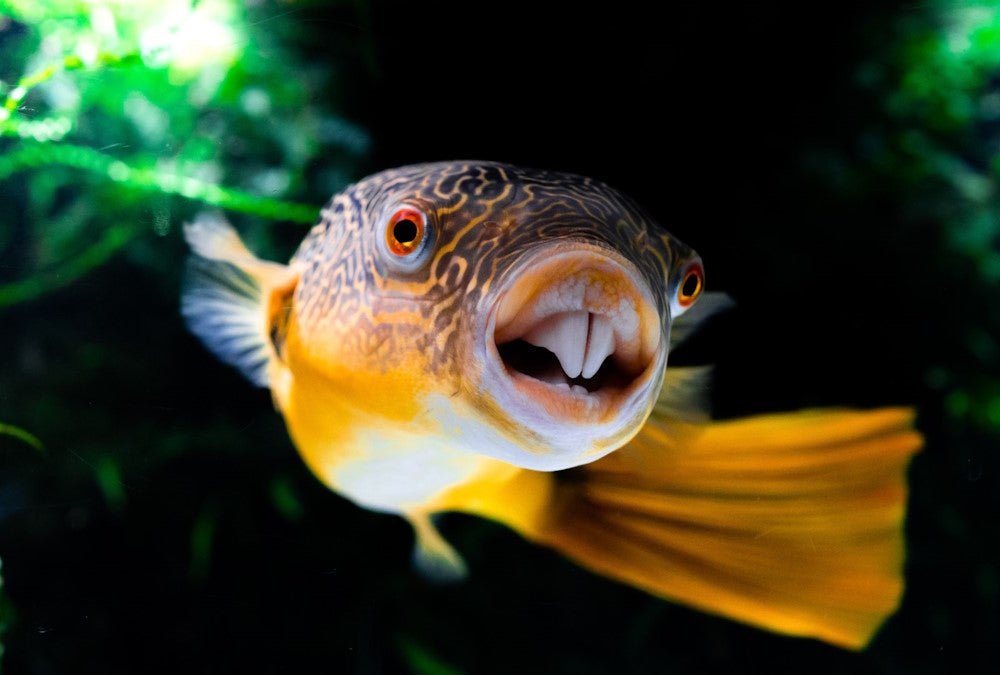
Our mascot, Murphy the Mbu puffer (Tetraodon mbu)
Of course, we couldn’t end our list without talking about our store mascot, the Mbu puffer. Our founder Cory fell in love with them because of their whimsical smile, detailed patterns, and bright yellow belly and tail. Clocking in at a whopping 30 inches (76 cm) long, they are the largest freshwater puffer in the world and require an aquarium with at least 6–8 feet (2 m) in length. The lakes and rivers from Africa that they call home consist of 75-79°F (24-26°C), pH above 7.0, and harder water. We personally stay away from any pointy hardscape or decorations that might accidentally scratch them and instead use live aquarium plants along the back and sides of the tank to serve as visual barriers.
Not only does a Mbu puffer require a monster fish tank, but its food bill costs hundreds of dollars every month. A beast this size can consume large amounts of clams, mussels, snails, crayfish, and other crustaceans. We tend to feed shelled or crunchy foods five times a week and softer foods (e.g., cocktail shrimp and frozen bloodworms soaked in vitamin supplements) twice a week. Because of their big appetite, expect to be cleaning out waste that looks like it belongs to a small dog.
Like the fahaka puffer, they are territorial towards their own species, and any tank mates you add must be quick and agile to escape predation. We've been successful keeping them with rummynose tetras, horseface loaches, hillstream loaches, Geophagus cichlids, and other species that won’t outcompete the puffer for food or inadvertently get in its way when it tries to feed. For more information on their care requirements, check out the full care sheet.
We hope you fall in love with pufferfish as much as we have and give them a shot. While we do not ship live fish, you can check out our online preferred retailers to see what they have in stock. For more fish stocking ideas, don’t forget to read about our top 7 oddball fish we recommend for a 29- or 30-gallon aquarium.
